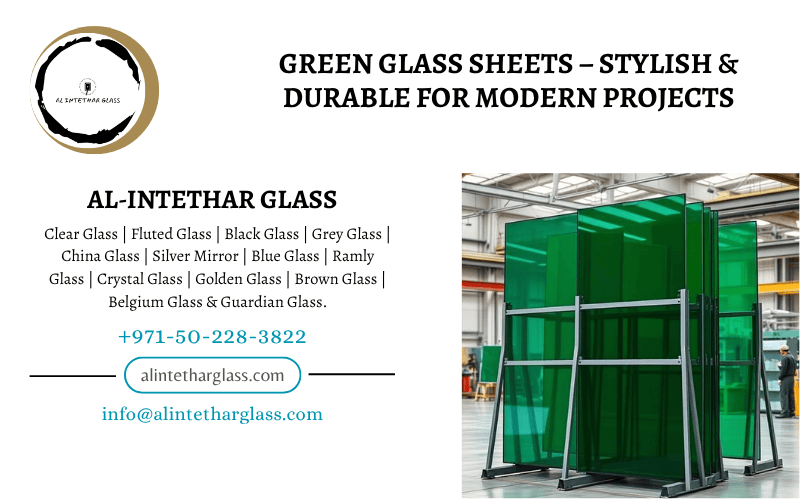Green Glass In the world of modern architecture and interior design, glass plays an essential role in defining beauty, transparency, and luxury. Among the wide variety of glass types available, Green Glass has gained significant attention for its aesthetic charm, energy efficiency, and eco-friendly characteristics. This type of glass is not only pleasing to the eye but also serves as a practical solution for both residential and commercial applications. From sleek facades to decorative interiors, Green Glass adds a refreshing touch of sophistication and sustainability to any space.
What is Green Glass?
is a type of tinted glass that features a subtle to deep green hue achieved by adding specific metal oxides—primarily iron oxide—during the manufacturing process. This tint not only enhances the glass’s visual appeal but also serves functional benefits such as reducing solar glare and minimizing heat transmission.
Unlike clear glass, which allows all visible light to pass through, green glass filters certain wavelengths, helping to control brightness and improve energy efficiency. Its distinctive color makes it popular for both modern and eco-conscious architectural designs.
The Manufacturing Process of Green Glass
The production of green glass follows the same basic float glass manufacturing method, with a unique tinting process added:
- Raw Material Preparation:
The main ingredients—silica sand, soda ash, limestone, and dolomite—are carefully mixed. To create the green tint, iron oxide is added to the mixture in specific proportions. - Melting and Float Process:
The mixture is melted at high temperatures (around 1500°C) in a furnace. The molten glass is then floated over a bath of molten tin, resulting in a smooth and uniform surface. - Annealing:
The glass is slowly cooled in an annealing lehr to relieve internal stresses and ensure durability. - Cutting and Finishing:
Once cooled, the glass sheets are cut to desired sizes, polished, and further processed for various uses such as tempering, lamination, or double glazing.
The entire process ensures that the glass maintains its green tint uniformly across the surface while preserving high optical clarity and strength.
Types of Green Glass
Depending on the desired look and function, is available in various forms:
- Standard Green Float Glass:
Commonly used for windows, doors, and facades, this type provides a balance of color and light control. - Reflective :
Coated with a reflective layer, it enhances privacy and reduces solar heat gain—perfect for commercial buildings. - Tempered :
Heat-treated for extra strength and safety, used in shower enclosures, balustrades, and facades. - Laminated :
Consists of two or more sheets bonded with a PVB interlayer, offering superior safety, sound insulation, and UV protection. - Double-Glazed :
Combines two glass panes separated by an air or gas-filled space, providing excellent insulation against heat and noise.
Key Features and Benefits of Green Glass
1. Energy Efficiency:
Green glass significantly reduces solar heat gain, keeping interiors cooler and lowering air-conditioning costs. This makes it a preferred material for energy-efficient buildings in hot climates.
2. UV Protection:
It blocks a substantial amount of harmful ultraviolet (UV) rays, protecting furniture, flooring, and artworks from fading or discoloration.
3. Glare Reduction:
The soft green tint minimizes glare from sunlight, improving comfort levels indoors without compromising natural light.
4. Aesthetic Appeal:
Its soothing green tone complements both modern and traditional designs. Whether used in exteriors or interiors, it adds a fresh, vibrant look to any setting.
5. Sustainability:
Green glass is environmentally friendly. Many manufacturers produce it using recycled materials, and it is fully recyclable at the end of its life cycle.
6. Privacy and Comfort:
Reflective and tinted versions of green glass provide better privacy while still allowing ample light transmission.
7. Durability:
When tempered or laminated, green glass becomes impact-resistant and shatter-proof, ensuring safety in high-traffic or high-rise structures.
Applications of Green Glass
1. Architectural Facades:
Green glass is widely used in building facades and curtain walls for offices, malls, and towers. Its reflective quality enhances aesthetics while maintaining energy performance.
2. Windows and Doors:
Residential and commercial properties use green-tinted windows and doors to achieve a stylish look with added thermal comfort.
3. Skylights and Atriums:
The glass allows natural light to flood in while reducing glare and heat, creating bright and comfortable spaces.
4. Interior Partitions and Walls:
Green glass partitions are trendy in modern offices and homes. They add a subtle color accent while maintaining an open, airy feel.
5. Furniture and Décor:
Green glass is also used in tabletops, shelves, mirrors, and decorative panels to create unique design statements.
6. Automotive Industry:
Many vehicles use green-tinted glass to protect passengers from UV rays and reduce heat inside the cabin.
Environmental Benefits
Green glass supports the concept of sustainable architecture. Its ability to regulate solar heat helps reduce dependence on artificial cooling systems, directly lowering energy consumption. Moreover, its production involves recyclable materials, aligning with global green building standards such as LEED (Leadership in Energy and Environmental Design).
By using green glass, builders and designers contribute to reducing the carbon footprint and promoting a healthier planet.
Design Versatility
Green glass blends beautifully with materials like aluminum, steel, wood, and stone. Its versatile tone ranges from light mint to deep emerald, giving architects the freedom to experiment with contrast, transparency, and reflection.
In interiors, it pairs perfectly with white, beige, and metallic tones, offering a luxurious and refreshing ambiance. For exteriors, it complements greenery and urban landscapes alike, providing a timeless, modern appeal.
Maintenance and Care
Maintaining green glass is easy and cost-effective. Regular cleaning with mild detergent and a soft cloth keeps the surface clear and glossy. Avoid using abrasive materials that could scratch the surface. Laminated or coated green glass should be cleaned carefully to protect the reflective or UV layers.
Conclusion
Green Glass is more than just a decorative material—it’s a fusion of style, performance, and sustainability. Its unique tint, energy-efficient properties, and aesthetic flexibility make it an ideal choice for architects, interior designers, and homeowners who seek a balance between beauty and function.
Tags: Green Glass

